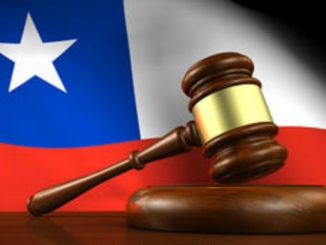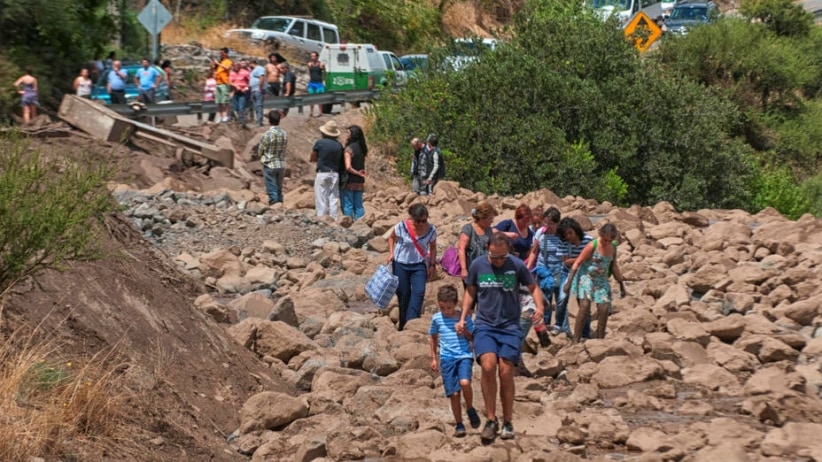
By Martin W.G. King / Special to the Santiago Times
Comfortably ensconced in airline-style seats on a new express train, my wife and I sped into downtown Toronto from a futuristic new terminal at the city’s international airport. What we saw was promising: shabby outer suburbs gave way to skyscraping forests of gleaming glass condo and office towers. Perhaps, we thought, considering the spectacular airport, the train (which offered the services of an on-board hostess) and all the new construction, everything we’d heard about Toronto’s renaissance was true, that it was, indeed the world’s newest great city, having already supplanted Chicago as the third-largest city in the United States and Canada and become the fourth-largest in North America (after Mexico City, New York and Los Angeles).
We had made a list of must-see sights for our weekend in Toronto, but ended up checking only a few boxes because there was so much to see and do within a walkable radius of our hotel (the city does have an efficient and user-friendly streetcar-and-subway transit system). We also did a lot of “visiting,” as my wife puts it; the people we encountered were unfailingly friendly, eager to provide directions and always available for a few minutes of conversation about the city in which they universally took great pride.
The sights that bit the dust included Kensington Market (a gargantuan, year-round ethnic bazaar); the brand new Aga Khan Museum, devoted to Islamic antiquities and culture; the Royal Ontario Museum (with a new addition by the renowned architect Daniel Libeskind); Little Italy; Greektown; at least one of the three Chinatowns; the uber-hip West Queen West area; and the Hockey Hall of Fame.
Toronto’s emergence on the world stage was a long time coming. But thanks to a tidal wave of immigration that started in the late 1960s, the city began to shed its staid image: The newcomers brought their cultures and cuisines with them, making the city a lively, multi-ethnic mosaic. Today, half of Toronto’s population is foreign-born, and residents speak more than 140 languages.
Toronto’s renaissance is also testimony to city fathers who, in 1965, not only built a new city hall in the heart of town with striking, curving towers and an elevated, clamshell council chamber, but put a huge square, with reflecting pools that double in winter as skating rinks, in front of it. The square quickly became a gathering place, with ethnic festivals, concerts and performances by street artists bringing people downtown at all hours.
Several years later, the Canadian National Railway Company built the CN Tower, a cloud-piercing telecommunications and observation tower that reigns as the tallest free-standing structure in North America and eclipses New York’s Freedom Tower by almost 200 feet. The tower prompted new downtown development. The views from the top are stunning, especially at night when the city’s bright lights spread far into the darkened landscape below. At the tower’s foot is the Rogers Centre, the home stadium of the MLB Toronto Blue Jays. The Air Canada Centre, home of the Toronto Raptors, the city’s NBA team, and the legendary Toronto Maple Leafs hockey team is a couple of blocks away.
Setting out from our hotel our first morning, we walked down Yonge Street (pronounced “young”), the city’s main north-south thoroughfare and, for miles on end, its major retail corridor, in the direction of the Financial District, near Lake Ontario. A shutterbug and architecture buff, I soon hauled out my camera to take pictures of both the exploding skyline and the vintage buildings that had been spared the wrecking ball and beautifully restored—and, to put all the new construction in context, some that hadn’t been restored.
Soon, we happened upon the campus of Ryerson University, with its striking, seven-story glass cube classroom building that seemed to tilt over the street. My wife darted into the university book store, which sat behind the cube, emerging triumphantly a few minutes later with a type of journal she could no longer find in the U.S. She sat by a fountain as I explored a farmer’s market in a pocket park adjoining the cube. A stand selling maple syrup and assorted maple syrup products (this was Canada, after all) caught my eye. The syrup came not just in the little bottles and cans familiar to Americans, but in giant 1.5 liter bottles as well.
Also catching my eye at the market was Ana Maria Diez, who was selling espresso drinks out of the Macchina Mobile Café, a bright orange, mid-century Vespa minivan—something, if you didn’t know better, you’d expect to see, say, in Milan, but not here in Toronto. Sampling a perfectly bold, piping hot Americano, I asked Diez what brought her to Toronto, and what she liked about the city. “Some of my relatives moved here in the 1970s,” she said. “It’s so diverse. I like the vibe.” Still, she didn’t care for Toronto’s winters, she said, noting that she spends them at home in South America.
Another market was in store for us—the 166-year old St. Lawrence Market, which National Geographic has called the world’s best food market. The market is a gourmand’s heaven, redolent with the aromas of baked goods, cheeses, fresh meats, fish, produce, flowers. One pastry stall sold exquisitely decorated cakes, but it was the cases of butter tarts, a sugary Canadian delicacy, that got my attention. For those who are squeamish, rest assured: A vendor told us that the spiked pig’s heads that once marked the stalls selling pea meal (“Canadian”) bacon—a sight that had horrified my wife on an earlier visit decades earlier–had been vanquished for good.

We stopped for lunch that day at the sidewalk café at the Hot House Restaurant and Bar, near the market. I ordered a Moroccan salad and a shrimp kebob, which was superb, the shrimp grilled perfectly, firm but full of flavor, while my wife’s chicken stirfry was also well executed. Sitting beneath an umbrella that provided shelter from the blistering June sun, I talked with our server,
Michael Lipka, an actor who came to Toronto seeking a career on stage and in the movies (many American movies are actually made in Toronto, and the annual Toronto International Film Festival each September attracts legions of critics and A-List stars and celebrities).
Lipka pointed out that Toronto is a big city for theatre—the third largest in the world, after London and New York. In fact, the Royal Alexandra Theatre, opened in 1907, is the oldest legitimate theatre in continuous operation in North America; other spaces include the Elgin Theatre, Winter Garden Theatre, Princess of Wales Theatre, Panasonic Theatre, Sony Centre for the Performing Arts and the Theatre Centre. (For music, there’s the Roy Thomson Hall, Koerner Hall and Massey Hall). The famed Stratford Festival (formerly the Stratford Shakespeare Festival) takes place each summer in Stratford, 96 miles from Toronto (round trip bus fare direct to venues is about $25).
Less than a mile from the market, the old 19th Century Gooderham and Worts whisky distillery has been converted into the Distillery Historic District, a compact area of shops, galleries and restaurants that we explored the next day. Down a quaint, cobbled lane, we came across a tiny boutique, Maisonette, which sold artisanal edibles, including chocolates made by Laura Slack, a well-known Toronto chocolatier and owner of the shop. Outside, a chest displayed frozen treats, popular on hot days like this one; inside, the shopkeeper, Natalia Nahon, a native of Venezuela, was eager to talk about the myriad confections that packed the shop’s shelves. Slack, she said, was known not just for her handpainted chocolate bars, but for her “Drink of the Gods,” a hot chocolate drink she sells in the winter.
We also stopped in at Bergo Designs, an emporium of high-end house wares, gifts, cards and novelty items. Blackbird Vintage Finds, around the corner, might have billed itself as selling everything but the kitchen sink—except that it had an antique kitchen sink for sale, as well as a variety of smaller antiques and gifts, including soaps from the Maison Apothecaire line (the pink grapefruit soap, in particular, was delightfully scented).
We ate a mid-afternoon lunch at El Catrin, a restaurant in the district that serves modern Mexican cuisine. Eating outdoors—there’s also a sophisticated interior space with Latin-themed murals—we dined on zesty made-to-order guacamole, calzador tacos (with spiced, sautéed mushrooms, superb) and the pollo burrito (with seasoned, marinated chicken and rich, dense black bean puree). Our server, Laura Vanegas, said she was originally from Colombia, but had lived in Montreal for 10 years before moving to Toronto. “The winters don’t bother me too much,” she said. “The people here are so friendly; it balances out.”
Our time being limited, we were able to check only two more things off our list. One was a ferry trip across the harbor to the heavily forested Toronto Islands, an oasis that offers beaches, a wildlife sanctuary, and an amusement park and zoo for small children. The midway at the Canadian National Exhibition, held in Toronto each year from late August through Labor Day, is vastly larger, with the usual heart-stopping rides for older kids and adults.
The other item we checked off was a visit to the vast Art Gallery of Ontario, a modern edifice redesigned by the famed architect Frank Gehry, a native of Toronto. Inside the gallery, and with only an hour to closing, we made a beeline for the Canadian collection, which includes an extensive collection of paintings by Canada’s famed Tom Thomson and the Group of Seven, early Twentieth Century artists who painted Canada’s rugged landscape in vivid colors and who are seen as counterparts to the famed “Ashcan” artists of the same period in the United States. We followed the signs to Canada’s most revered work of art, Thomson’s The Jack Pine. We were so absorbed that we had to pass up the European wing and one of the museum’s prime attractions, an extensive collection of works by sculptor Henry Moore.
The next day, as we boarded the train for the airport, the hostess, a young Muslim woman in a head scarf, helped us stow our luggage and then, seeing us with our phones, offered to take our picture. We decided it wasn’t just the skyscrapers, architecture, art galleries or the surprises around every corner that had made Toronto so special: It was the people.
Top Sights and Attractions in Toronto
In Canadian dollars; most attractions offer discounts for children and seniors.
Aga Khan Museum – New museum of Islamic antiquities and culture, particularly of Iran; $20; 77 Wynford Drive, 416-646-4677, https://www.agakhanmuseum.org/
Art Gallery of Ontario – 80,000 pieces of art from the first century to the present day, excellent Canadian collection; $19.50; 317 Dundas Street West, 416-979-6648, http://www.ago.net/
CN Tower – One of the world’s highest observation decks, $33; Edge Walk (full circle hands-free walk on the roof of the observation pod, $195, 916-601-3833 for Edge Walk information); 301 Front Street West, 416-868-6937, http://www.cntower.ca/intro.html
Historic Distillery District – With an entrance at 55 Mill Street, the 47 buildings of a 19th Century whisky distillery are occupied by art galleries, shops and restaurants; special events schedule; free; 416-364-1177, http://www.thedistillerydistrict.com/
Hockey Hall of Fame – Museum of Canada’s national pastime, home of the Stanley Cup, $18; 30 Yonge Street, 416-360-7735, http://www.hhof.com/
Kensington Market – Hundreds of predominantly ethnic shops and vendors selling everything from antiques, fabrics and ceramics to every type of edible; bordered by College Street and West Dundas Street on the north and south and Spadina Avenue and Bathurst Street on the east and west; http://www.kensington-market.ca/Default.asp?id=home&l=1
McMichael Canadian Art Collection – Museum dedicated to Canada’s Group of Seven and Inuit artists; wilderness setting with footpaths; $18; 10365 Islington Avenue, Kleinburg, ON (just north of Toronto), 905-893-1121, http://50years.mcmichael.com/
Ripley’s Aquarium of Canada – Ocean life exhibits, including galleries dedicated to Canadian waters, tropical reefs and dangerous sea creatures; $30; 288 Bremner Boulevard, 647-351-3474, https://www.ripleyaquariums.com/canada/
Royal Ontario Museum – Art, world culture and natural history with an addition in the shape of a giant crystal; $17; 100 Queens Park, 416-586-8000, http://www.rom.on.ca/en#/gallery/recent
St. Lawrence Market – 100-plus vendors in, according to the National Geographic, the world’s best food market, free admission; 92-95 Front Street East, 416-392-7219, http://www.stlawrencemarket.com/
Toronto Zoo – 5,000 animals representing 500 species, including giant panda cubs; $28; 2000 Meadowvale Road, 416-392-5929, http://www.torontozoo.com/
Where To Eat in Toronto
(Ranked from most to least expensive)
Annona Restaurant – Locally inspired cuisine at the Park Hyatt Hotel in the exclusive Yorkville retail area, sumptuous afternoon tea, Kosher meals on specified dates each month, very expensive; 4 Avenue Road, 416-324-1567, http://hyatt.com/gallery/torphannon/
360 – The revolving restaurant atop the CN Tower, prix-fixe dining featuring Canadian ingredients and wines with spectacular views, very expensive; 301 Front Street West, 416-362-5411, http://www.cntower.ca/en-ca/360-restaurant/overview.html
Le Select Bistro – Sustainable French cuisine, indoor and outdoor seating, numerous awards, including one from Wine Spectator; expensive; 432 Wellington Street West, 416-596-6405, http://www.leselect.com/
Mercatto – Italian cuisine in a trendy setting, moderate to expensive; 15 Toronto Street, 416-366-4567, http://mercatto.ca/toronto-street/
El Catrin – Inventive Mexican small plates and entrees, large outdoor patio (heated) and indoor dining room, Distillery Historic District, moderate; 18 Tank House Lane, 416-203-2121, http://www.elcatrin.ca/home
Hot House Restaurant and Bar – Excellent food that draws on numerous cultures, casual, moderate; 35 Church Street, 416-366-7800, http://www.hothouserestaurant.com/
Pai Northern Thai Kitchen – Rated the 9th best restaurant in Toronto by Trip Advisor, inexpensive to moderate; 18 Duncan Street, 416-901-4724, http://www.paitoronto.com/#main
Senator Restaurant – A classic diner, Toronto’s oldest restaurant, comfort food at inexpensive to moderate prices; 249 Victoria Street, 416-364-7517, http://thesenator.com/
The Pilot – Inexpensive burgers and other rudimentary menu items; rooftop deck, casual, jazz some nights; open late; 22 Cumberland Street, 416-923-5716, http://www.thepilot.ca/
The Jerk Joint – Caribbean cuisine, often rated the best ethnic restaurant in Toronto, very inexpensive; 238 Queen Street West, 647-748-7011, http://www.jerkjointtoronto.com/
Where to Stay in Toronto
All rates are in Canadian dollars and were recently found on the hotels’ websites for August 18-22. Hotels are ranked from most to least expensive. The U.S. equivalent is usually 25-30 percent less.
Park Hyatt Toronto – Chic, uptown luxury near the exclusive Yorkville shopping district, swank rooftop bar, formal afternoon tea, complimentary car service, from $319; 4 Avenue Road, 416-925-1234, http://toronto.park.hyatt.com/en/hotel/home.html
Fairmont Royal York – Downtown luxury near a transportation nexus, pool, from $255; 100 Front Street West, 416-368-2511, http://www.fairmont.com/royal-york-toronto/
Omni King Edward Hotel – Historic downtown elegance, refined décor, popular cocktail lounge, formal afternoon tea; from $207; 37 King Street East, 416-863-9700, https://www.omnihotels.com/hotels/toronto-king-edward
Courtyard Toronto Downtown – A discount Marriott brand, pool, renovated rooms from $215; 475 Yonge Street, 416-924-0611, http://www.marriott.com/hotels/travel/yyzcy-courtyard-toronto-downtown/?scid=bb1a189a-fec3-4d19-a255-54ba596febe2
Chelsea Hotel – Midtown convenience and modern, comfortable rooms near lively Yonge-Dundas Square, separate pools for adults and families with children (130-foot corkscrew water slide in family pool), from $175; 33 Gerrard Street West, 800-243-5732, http://www.chelseatoronto.com/en/
Town Inn Suites – Spacious, recently renovated uptown accommodations near exclusive Yorkville; from $574 total for entire four-night stay (daily rate varies with length of stay): 620 Church Street, 800-387-2755; http://www.towninn.com
Hotel Carlingview Toronto Airport – Pleasant rooms, suburban location about 18 miles from downtown, from $348 total for entire four-night stay (daily rate changes depending on length of stay); 221 Carlingview Drive, 877-675-3303, http://www.carlingview.ca/
Film Festival Draws Celebrities—and Crowds
The Toronto International Film Festival has become a major stop on the international film circuit, attracting more than 400,000 moviegoers—and multitudes of A-List critics and celebrities—to movie premieres, lectures and glamorous social events. This year, it runs from September 8 through September 18 at a gargantuan, $181 million state-of the art downtown facility (the TIFF Bell Lightbox, the festival’s permanent home, 350 King Street West) and other locations. Hotels and restaurants are reserved early for the festival dates; book early if you plan to attend. Festival and ticket information: 416-599-TIFF, http://tiff.net/festivals/festival16/tickets.
Canadian National Exhibition Caps Summer
Toronto winds up summer with a lot of razzmatazz – the annual Canadian National Exhibition (“The Ex” to Torontonians), which occupies a permanent 192-acre site west of downtown on the shore of Lake Ontario. In recent years attendance has skyrocketed to 1.6 million for the 18-day fair, which begins August 19 and runs through September 5, Labor Day.
The exhibition offers all the staples of state fairs—farming, floral and food shows with, this year, an international celebrity chef competition, as well as an aerial-acrobatics-and-ice skating show; a full schedule of concerts and stage productions (with an accent on ethnic culture); and aerial shows featuring Canada’s air force “Snowbirds” on the Labor Day weekend. Other exhibits focus on science and technology. Midway rides include the death-defying Mach 3 and Blitz as well as a more traditional roller coaster—tame in comparison.
Ample public transportation to the exhibition site is available from downtown Toronto, including an express, nonstop bus from the Bathurst West subway station. A weekend, one-day transit pass is $11.50 per family anywhere on the system.
Admission to the exhibition is $18 (Canadian) at the gate (there are discounts for ordering in advance online). There are also discounts for children, teens and seniors. All-day passes that include unlimited midway rides are available for $40 per person if purchased online before opening day (http://theex.com/main/guest-info/tickets/admission-tickets).
The exhibition is at Toronto’s Exhibition Place, north of Lake Shore Boulevard West between Strachan and Dufferin Streets.
More information: 416-263-3800, http://theex.com/.










